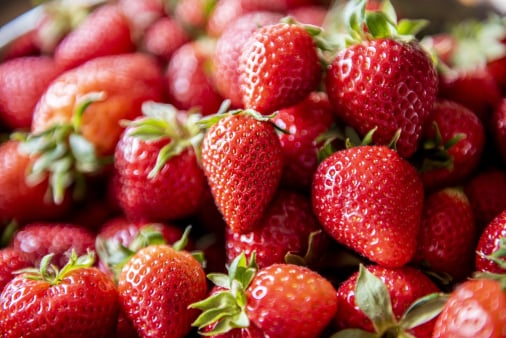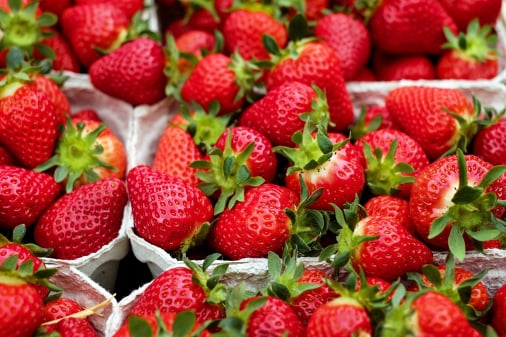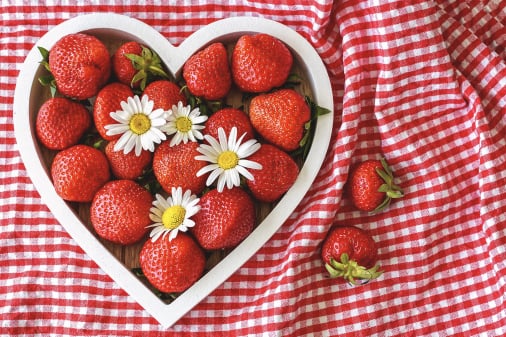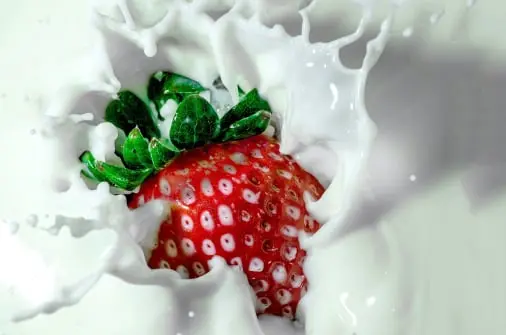Strawberry traceability app:
Strawberry traceability app for strawberry packing, processing and strawberry value add, sales/export. Manage strawberry traceability up and down supply chain, instant strawberry recalls and audits.

Strawberry Traceability during production & packing
View Traceability App Specifications.
STRAWBERRY TRACEABILTY MANAGEMENT
Multi-Chemical Profiling of Strawberry as a Traceability Tool to Investigate the Effect of Cultivar and Cultivation Conditions
The chemical composition of foods is tightly regulated by multiple genotypic and agronomic factors, which can thus serve as potential descriptors for traceability and authentication purposes. In the present work, we performed a multi-chemical characterization of strawberry fruits from five varieties (Aromas, Camarosa, Diamante, Medina, and Ventana) grown in two cultivation systems (open/closed soilless systems) during two consecutive campaigns with different climatic conditions (rainfall and temperature). For this purpose, we analyzed multiple components closely related to the sensory and health characteristics of strawberry, including sugars, organic acids, phenolic compounds, and essential and non-essential mineral elements, and various complementary statistical approaches were applied for selecting chemical descriptors of cultivar and agronomic conditions. Anthocyanins, phenolic acids, sucrose, and malic acid were found to be the most discriminant variables among cultivars, while climatic conditions and the cultivation system were behind changes in polyphenol contents. These results thus demonstrate the utility of combining multi-chemical profiling approaches with advanced chemometric tools in food traceability research.
Keywords: cultivar; cultivation system; mineral elements; organic acids; phenolic compounds; strawberry; sugars; traceability.
STRAWBERRY TRACEABILITY & RECALLS / AUDITS
The chemical composition of foods is tightly regulated by multiple genotypic and agronomic factors, which can thus serve as potential descriptors for traceability and authentication purposes. In the present work, we performed a multi-chemical characterization of strawberry fruits from five varieties (Aromas, Camarosa, Diamante, Medina, and Ventana) grown in two cultivation systems (open/closed soilless systems) during two consecutive campaigns with different climatic conditions (rainfall and temperature). For this purpose, we analyzed multiple components closely related to the sensory and health characteristics of strawberry, including sugars, organic acids, phenolic compounds, and essential and non-essential mineral elements, and various complementary statistical approaches were applied for selecting chemical descriptors of cultivar and agronomic conditions. Anthocyanins, phenolic acids, sucrose, and malic acid were found to be the most discriminant variables among cultivars, while climatic conditions and the cultivation system were behind changes in polyphenol contents. These results thus demonstrate the utility of combining multi-chemical profiling approaches with advanced chemometric tools in food traceability research.
“We want to ensure the traceability and safety of our strawberries”
Strawberry production in Peru is on the rise, and due to both the country’s climate as well as the increasing popularity of IQF, they are able to export the product year-round.
Agro Natural Park SAC works with mango and avocado producing associations in Norte Chico and Norte del Perú, but they also produce strawberries and raspberries. Currently, they are in the middle of their strawberry season.

Strawberry packhouse hygiene checklist for food safety
Jose Cordero, the company’s general manager, says: “Our fields comprise about 30 hectares for the strawberry cultivation and are located in the valleys of the Norte Chico region in Peru. We started our harvest in July and will continue to harvest until the end of the December – this year we will produce approximately 150 tons of strawberries, which will be processed with an IQF procedure prior to export.”
The volumes of exported IQF strawberries in Peru experienced a huge jump between 2017 and 2018, Jose says. “In 2017, Peru exported 6.5 million kilos, and then in 2018 the number went up to 9.3 million. This year the numbers have remained steady and similar to last year. We had a cold year this year, for our standards, and this has kept the volumes from increasing this year – but we are happy with the level of production we are seeing this year. We’ll be exporting the product to markets in North America, Asia, and Europe, but there are also quite large volumes entering the domestic market here.”
The strawberries in Peru are grown using either a gravity system, or a technified irrigation system. Jose explains: “We currently use the technified irrigation system, but next year we hope to also begin using the Macro Tunnel design, which is a type of greenhouse, in order to innovate our production – this should help increase both the quantity and the quality of our product. Our main varieties are the San Andreas, Aromas, and the Camarosa, but we are seeing a lot of innovation in strawberry varieties and so while these varieties are popular now, in the future I think we will see other varieties enter the market.”
Jose continued: “Our goal as a company is to provide the customer with a product without toxic waste, and we use the strictest international controls on our fruit – such as GlobalGap. Our fields are managed with MIP and BPA programs. We are also working with six new varieties of bio-insecticides for our strawberries that have been giving good results. For now, we focus on trying the deliver the best product we can. We produce our strawberries in our own fields, which helps ensure the traceability and the safety of our production, which is something that is very important to us,” Jose concludes.
STRAWBERRY TRACEABILITY CERTIFICATION
Traceability for Fresh & Processed Fruits, Vegetables and Cut Flowers
Filed Under: Certification | Tagged: 2020 Certification Program, Supply Chain Certification, Traceability, Bananas, Flowers
Last updated May 25, 2021

Strawberry Traceability management best practices
Marketplace 2.0, the Rainforest Alliance online traceability platform, now includes all fresh and processed fruits, vegetables and cut flowers, so it is even easier to trace Rainforest Alliance Certified products through supply chains, and to authorize trademark approvals.
Traceability matters
Our stakeholders – including consumers, brands, other NGOs, and consumer advocacy groups –regularly challenge us to demonstrate how we ensure our claims of Rainforest Alliance Certified content. Traceability helps us back up the claim that any products bearing the Rainforest Alliance seal come from Rainforest Alliance Certified sources. It means that consumers and companies can trace a product back to a Rainforest Alliance certified farm of group. This process helps us safeguard the integrity of the Rainforest Alliance seal.
Collecting this data centrally at the Rainforest Alliance, allows us to have visibility through the entire supply chain, from origin to final distribution, and thus can assure the integrity of the Rainforest Alliance seal.
Every stage of its journey documented, so consumers are certain of what they are buying. Companies can also benefit from traceability because it can make their supply chains more transparent, identify possible weak spots and work on further improvements. And farmers can track farm development, but also gain access to new markets.
Food & Beverage Traceability Top of Mind for Consumers
Posted by Brooke Lester on Jul 28, 2021 12:18 PM
Food & Beverage Traceability Top of Mind for Consumers
Over the past decade, consumers have become more curious about where their food and beverages come from. That curiosity became a concern in 2020 when a global pandemic struck. Factories shut down as workers became sick.
Even as we begin recovering from the pandemic, consumers still want food traceability. Read on to learn how to incorporate food traceability with supply chain management.
The Need for Greater Food Traceability
Consumers have begun to care about how their food and beverages are manufactured – are processes sustainable? Are workers treated ethically? They’ve started to demand greater food traceability.
The coronavirus amplified the need for food traceability. Workers in meatpacking and processing plants became sick, which shut down facilities and caused meat shortages. Consumers became concerned that they too could get ill from contaminated food.
How Can Manufacturers Incorporate Food Traceability into Supply Chain Management?
When all of your suppliers were local, it was possible to keep records with paper and pencil. That’s no longer the case anymore – food and beverage manufacturers purchase raw materials from all over the world. Manual processes don’t give you visibility into the supply chain; in fact, they only complicate it.
With the right technology, manufacturers can incorporate food traceability into supply chain management. B2B integration brings information from systems of record into one place, making it easier to trace raw materials all through the supply chain.
“B2B integration enables food traceability into the supply chain.”
Here’s how it works: when a shipment of raw materials comes in, the B2B integration solution tracks the lot number. It records every product in which those raw ingredients are used.

Strawberry Supplier Traceability Management
As it turns out, the strawberries were contaminated. They could cause consumers to be ill or even die. Once Rosewood figures out that the strawberries are contaminated, they have to take action immediately. Their B2B integration solution allows the company to identify precisely which lots the contaminated strawberries were used in.
They can quickly pull the contaminated lots from shelves. That move prevents customers from getting sick and helps Rosewood avoid regulatory fines.
“B2B integration makes it faster to pull faulty products from shelves.”
Food traceability will eventually focus on sustainability and ethical manufacturing in addition to safety. B2B integration can meet that need, too. It integrates with technologies such as blockchain. Blockchain creates a digital ledger of transactions.
One example comes from coffee production; some companies use the blockchain so customers can see where their beans come from and how much manufacturers pay farmers for beans.
“B2B integration works with blockchain to increase food traceability.”
Food and beverage companies can meet the demands of consumers for greater food traceability with the right technology. B2B integration brings all of your information into one place, making it simpler to track shipments of raw materials throughout the manufacturing process"
STRAWBERRY TRACEABILITY APP
The objective of the present research was to define a traceability system for organic fruits (orange, peach and strawberry) to monitor the classical parameters of quality (carpometric characteristics, total soluble solids (TSS), total acidity (TA), and ascorbic acid). We also aimed to monitor the parameters of several plant metabolites, such as synephrine in orange juice, ellagic acid in strawberries, and phenolic and volatile compounds in peaches, whose biosynthesis could be influenced by the use of an organic or conventional cultivation system. In addition, taking into account several specific aspects of the two cultivation methods, such as the different kinds of nitrogen soil fertilization used, a study was carried out to verify the possibility to differentiate between organically and conventionally grown fruit through the detection of markers linked to nitrogen metabolism. The ratio of stable isotopes of nitrogen 15N/14N in the proteins of pulp (delta15N PP) of different fruit species was determined. Our results showed that the cultivation method did not determine relevant differences in the quality parameters in oranges and peaches, whereas in strawberries, differences between organic and conventional fruits were observed. The ascorbic acid content in the three species studied was always higher in the organic fruits. Moreover, the level of bioactive compounds, such as skin anthocyanins in the ‘Spring Lady’ peach cultivar, was higher in the organically grown fruits. Peaches and oranges from organically managed farms had statistically higher delta15N PP values compared with the conventional ones. Therefore, the application of organic fertilizers, which notoriously increase the level of delta15N in the soil, also leads to an increase of delta15N values in the organic fruit. For that reason, this parameter can be used as a new marker to differentiate organically from conventionally grown fruit. Regarding the delta15N level found in strawberry pulp, no difference was observed between organic and conventional fruits because organic fertilizers are often employed even in conventional systems.